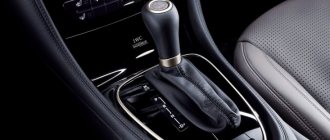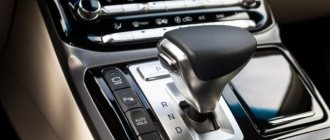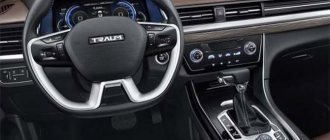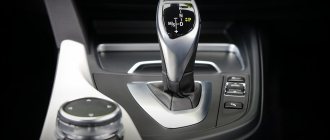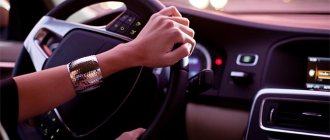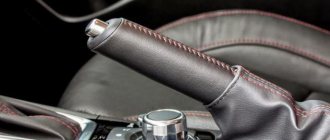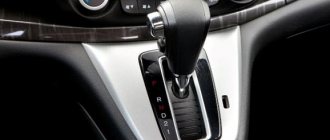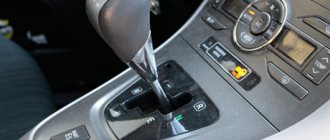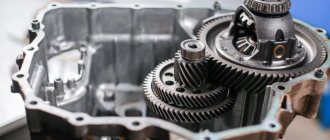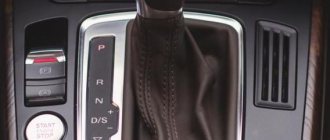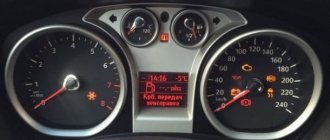Features of driving an automatic after a manual
Although the design of an automatic transmission is much more complex than its mechanical counterpart, it is easier to drive such a car. Operation of the automatic transmission is simpler and more convenient than all other existing transmissions.
After driving a car with a manual transmission, it is difficult to get used to driving without a third pedal in the cabin. There is no clutch, so braking is done with one pedal. To change the direction of movement, the car switches R-backward or D-forward, after pressing the brake.
Anyone who has replaced a manual transmission with an automatic equivalent is advised to drive with their left leg relaxed and positioned closer to the seat, and kept away from the pedal assembly. Steer with your right foot only.
Cars of the future and the role of pedals in driving
Most likely, in a few years, management standards will change significantly. Car manufacturers will begin to abandon the usual way of organizing control and introduce new technologies. For example, some concerns already have developed cars that read road signs and do not allow the driver to break the speed limit. There are also new car models that can automatically brake before obstacles, drive on autopilot in traffic jams and avoid people or animals that suddenly appear on the road. Such developments will lead to the following:
- the pedals in the car will remain as an emergency control system for car functions;
- the role of gear shifting will shift to paddle shifters, and manual transmissions will completely disappear from mass production;
- braking will be carried out using a simpler method, and even with the help of a computer;
- The automatic functions of the machine will allow you to adjust the desired speed and enjoy the absence of the need for the same foot position during the trip.
Today you can use cruise control and not have to constantly keep your foot on the gas pedal while driving. This function allows you to make the trip much more comfortable, free your legs and get more comfort from the movement. With the help of new developments, such modes are safe and very comfortable. And in cars of the near future, such technologies will become more widespread. If anyone has problems with the usual controls in the form of pedals on a car, watch the following video:
Rules for driving an automatic car
Follow a few simple rules to help those taking their first automatic driving lessons get the maximum benefit and comfort from driving in any situation and in any weather conditions:
- The gas pedal should be pressed halfway, this allows you to drive with smooth acceleration and save fuel;
- If you need to speed up while moving, push to the floor;
- The neutral position of the automatic transmission is used to move automatic vehicles around the city in tow (lowest speed and not far);
- When stopping for short periods at traffic lights, do not use the “P” or “N” positions, use them for long stops;
- The car should be held with the brake or handbrake when climbing. If you drive uphill on the accelerator, the box will overheat;
- When maneuvering in a parking lot or near a garage, you should drive while controlling your speed with the brakes. In position “R” or “D” the vehicle moves itself;
- In order for the automatic transmission to work properly during cold periods, the oil in it should be warmed up after parking with the engine for about 5 minutes before driving. To warm up the oil in the transmission, turn on the handbrake, depress the brake and alternately switch modes D and R for a short time;
- In order for a car with an automatic rifle to easily get out of a snowdrift, use modes “1”, “2” or “L”. You must first turn off ESP, which is responsible for stabilizing the car and interfering with driving;
- To prevent brake pads from freezing to the drums (or discs) in winter, you should park on a flat surface, using the “P” position and without using the handbrake.
Gas and brake pedal
Driving with an automatic transmission requires only two pedals:
- The brake pedal is located on the left and is pressed with the right foot to reduce speed or completely stop the vehicle.
- The force applied to this pedal regulates the smooth acceleration and braking of the car. It is dangerous to press the brakes while moving at high speed, or when overcoming potholes and other irregularities - in this case, all wheels are blocked, which not only breaks the entire suspension, but can help you fly into a ditch;
- “Gas” is pressed with the right foot (located on the right). The left one must be kept on the platform when moving, so as not to accidentally use them at the same time; this should not be allowed. The accelerator is very sensitive; to increase speed, it should be pressed lightly and gradually. To reduce the speed of movement, you must first release the accelerator, then squeeze the brakes;
Types of pedals
In a manual transmission, opposite the driver's seat, there are three pedals below.
Clutch pedal
The first pedal is the clutch pedal. It's on the left. The clutch pedal sets the car in motion by transmitting torque to the wheels. Also, the function of the clutch pedal is to change gears - in this case, the pedal should be depressed with your left foot.
In order to move smoothly you need to:
- Gently release the clutch pedal while gently pressing the gas pedal;
- Depress the pedal (at this moment the driving and driven clutch discs, which are pressed against each other, begin to separate, and the engine torque ceases to be transmitted to the gearbox, and the gearbox input shaft, which is connected to the driven disc, stops);
- Engage first gear;
- Smoothly release the clutch pedal while gently pressing the gas pedal.
If the car is set to the parking brake and tilted towards the road, then before starting to move, the pedal must first be released from the brake, which is logical. This makes things a little more difficult. However, with practice, any such actions will not seem difficult, but will be performed automatically by you.
In general, in order to better feel and understand the mechanism of the clutch at the moment when the car starts to move, try to practice on roads with a slight downward slope - in this case, you don’t have to touch the gas pedal at the beginning - then the engine will stall. When switching gears with the clutch pedal, you must, on the contrary, press and release it quickly, in order to avoid them slipping relative to each other at the moment when the clutch discs are connected, as the friction linings may burn out.
Advertisement
Brake pedal
The brake pedal is located in the middle between the gas pedal and the clutch pedal.
You can activate it with your right foot. In fact, the brake pedal is practically the most important part of the car, since a lot depends on it.
Its function is to stop the car if necessary, and this need can arise at any time on the road.
By activating it, the driver gives the car a signal to gradually or sharply (in emergency situations) reduce the speed.
The car's braking system is equipped with a brake booster. If, in order to brake, you need to make a considerable amount of effort, then it is recommended to have your car checked at a service station.
The pedal is located on the right side. Its function is to increase the supply of fuel to the combustion chambers. In other words, the pedal maintains and smoothly changes the speed of the machine. If you press the pedal, acceleration will occur; if you release it, the car will slow down. If you do not change the position of this pedal, the car will move at a stable speed. You need to depress the gas pedal very smoothly. At the moment of pressing, the lower leg is activated, and the knee joint comes into a relaxed state.
How to start driving a car with an automatic transmission?
To start automatic movements, you need to do the following:
- Switch the gearbox selector lever to position “P”;
- Depress the brake pedal;
- Start the engine;
- Activate travel mode;
- Switch the turn signals in the direction of travel;
- Check whether your car will be a nuisance on the road;
- The brake is smoothly released and you can drive in the given direction;
Here is the answer to how to start driving automatically, detailed step-by-step instructions, following which you will always easily drive without problems.
Automatic transmission modes
Any automatic transmission has 4 main operating modes:
- D – “drive” – means the car is moving forward. If positions 4, 3 and 2 are present, they indicate forward movement in 4th, 3rd or 2nd gear. It is allowed to drive even with a trailer or on steep slopes and sudden braking. Some modifications have a “B” mode, especially for driving with extreme braking, long descents and driving with a trailer, while the box switches to the lowest gear. Using positions “4”, “3” or “2” while driving is allowed if the car is traveling at a speed acceptable for the given position of the lever. The first speed is allowed starting from the first mark on the speedometer, the second speed is two marks on the speedometer, the fourth speed is the beginning of 4 marks, respectively, this is the correct range to avoid damage to the box;
- N – “neutral” – when you need to roll the car away without starting. When the brake is released, the car rolls freely. According to the instructions, you cannot roll the car for a long time in this mode, it can damage the box.” Therefore, only use it when absolutely necessary and not for long;
- P – “parking” – serves to leave vehicles motionless for a long time. This will fix the position of the car in the parking lot. Turn on parking mode when the car has stopped. The engine is started in the parking position, the car will not move, and the engine will pick up idle speed;
- R – “reverse” - used to drive backwards, switches when the vehicle has stopped;
Getting started correctly with automatic transmission
In recent years, more and more cars are equipped with a START-STOP-Engine (SSE) button, which turns on the ignition and starts the engine. The system is advantageous in that it simultaneously serves as an anti-theft agent that responds to the car’s “native” electronic key: if it is not inside the car, the loop antenna in the doors will lock the locks and stop the engine.
The SSE system can be installed either factory-installed or independently.
Options for starting the engine with the SSE button:
- With the turn of a key and the press of a button.
- Without using a key.
- Using the brake pedal.
- Without using the brake pedal.
- With or without delay start.
The sequence of actions to set the car in motion will be as follows:
- We sat in the driver's seat and buckled up.
- Adjust the seat position. To do this, you need to move it away from the steering wheel so that, with the backrest positioned at about 100⁰, you can easily reach the pedals with your feet (your legs should be slightly bent). The knees are at the same level as the hips. There should be a gap of 2 fingers between the seat and the bend of your knees, and your buttocks should be as close to the back of the seat as possible.
- When adjusting the seat correctly, your hands should be in the position: the right hand is “3 o’clock”, the left hand is “9 o’clock”, if you imagine the steering wheel as a watch dial.
Correct seating in the car - Set up mirrors. All three mirrors should complement each other as much as possible, minimizing the “dead zone” inaccessible to view. They are configured during parking.
- In the left mirror, when you tilt your head to your shoulder, you should be able to see the rear fender of our car and the road surface with markings. The road must occupy at least 60% of the reflection in the mirror.
- In the right mirror, when the head is tilted to the longitudinal axis of the car, the rear fender should be visible, and with the head in a normal position, part of the rear bumper should be visible.
- The horizon lines in both mirrors are set according to the principle of 40% - sky, 60% - earth.
- The interior mirror brings together the information received by the driver, complementing the views in the left and right mirrors. To adjust it, take a comfortable position in the chair and adjust it so that the rear window of the car is displayed as much as possible.
- Sometimes round parabolic reflectors are glued onto mirrors to increase the viewing angle. But it is better for novice drivers not to use them, as they distort the distance to real objects.
- We made sure that the automatic transmission lever is in the “park” position P. It is in a different position - switched to the indicated ones!
Gearbox lever in park position - Press the brake pedal all the way, start the car with the key or the start button. The brake pedal is still pressed!
- The gearbox mode selection lever is switched to “drive” mode, or D.
Be sure to watch the video for more details:
Start of movement
Any trip begins with starting and warming up the engine. Don't rush to start moving right away. If the temperature outside is above zero, it is enough to wait a minute or two for the oil to distribute throughout the box and for it to return to operating mode. Remember, the colder it is outside, the longer it will take to warm up, so in cold weather it won’t hurt to stand with the engine running for 10 minutes or more. In addition, this will also be a plus for the car engine.
Reminder!
The engine can only be started in positions
“P”
or
“N”
.
Moreover, preferably in the “P”
. If your car does not start, check that the gearbox lever is set to one of these two positions.
So, you have warmed up the car, now you can start driving. Shift the transmission lever from the “P”
into one of the driving positions and
be sure to wait for the easy point
! The box takes some time to switch modes (usually about 1 second), and if you sharply press the gas before this point, it may cause damage.
Additional modes
There are a number of provisions that are not used in all automatic transmissions:
- Position “2” – only stages 1 and 2 will be turned on, the rest are blocked. Used when towing or driving a car on winding mountain roads. You can also drive in the city if the car speed is allowed no higher than 80 km/h. In other cases, this mode prevents acceleration to high speed and increases the load on the automatic transmission;
- Position “L” – the lowest stage is activated. Designed for off-road driving. On SUVs, this mode starts a lowering stage, which allows you to drive through mud and muddy places. In “L” mode, the vehicle speed is no higher than 15 km/h. It is recommended to turn on the off-road mode in advance;
- The “OverDrive” (O/D) position is used on automatic transmissions with more than three gears and is used to perform an overtaking maneuver or sharp acceleration of the car. Usually this is a button on the selector. It does not allow driving at speeds higher than the capabilities of third gear, due to this, the driving dynamics of the car are increased. Convenient for long uphill climbs, when without this mode the gearbox can cause vibrations in 3rd-4th gear, the “overdrive” position solves the problem;
- “PWR/SPORT” position. This sporty style is for going fast. Activation causes gears to be engaged at high speed, thereby increasing the speed of the car (and fuel consumption). To fully experience the full power of this style, you need to adapt to driving an automatic, because the car responds sharper to the accelerator and is more difficult to control;
- “SNOW” position – snow. Designed for winter use, driving on snowy roads. The car will start moving from second gear, and gear shifts occur at lower speeds. On asphalt, the car's dynamics in this mode are reduced because it is for snow;
Main modes:
"P"
Motorcycles with automatic transmission: Honda
This mode is used when parking. You can turn it on only after the car has come to a complete stop on a level surface. The transition to “P” mode is carried out before the brake pedal is released. After switching, the motor will be disconnected from the transmission. An additional gear is used for locking.
Important: if you use “P” while driving, you can break the locking gear, which can lead to expensive engine repairs. Also, you cannot use the described mode without the car’s hand brake, when parking on a slope exceeding 15 degrees.
Also, you cannot use the described mode without the car’s hand brake, when parking on a slope exceeding 15 degrees.
"R"
Reverse driving mode. Reverse can only be activated after the vehicle has come to a complete stop. Before starting to move backwards, you should wait approximately 1.5 seconds. Without pressing the lock button on the automatic transmission handle, you can only switch from this mode to neutral.
"N"
Neutral gear. In it, the engine idles (does not transmit torque to the wheels). Typically, neutral is used for short stops. It is highly not recommended to engage neutral gear until the car has stopped. Neutral is also used when towing a car. In this case, towing should take place at a speed no higher than 45 km/h (and for a short time).
You can return to the same mode without removing the button from the “Drive” mode when you come to a complete stop.
"D", "D1", "D2", "D3"
The main operating mode of the automatic transmission is indicated by the letter “D”. Driving in 4 gears. In this mode, depending on the current pressure of the gas pedal, the electronics itself will downshift or upshift.
Modes designated simply by numbers (1, 2, 3) or the letter “D” with one of the numbers mean lower gears. Accordingly, in 3 gear the box will not shift above third gear. In 2nd gear the automatic transmission will not shift above 2nd gear.
Mode “D1” or “1” or “L” is the use of only first gear. It is used in cases where the vehicle speed cannot exceed 25 km/h. Under no circumstances should this mode be activated while driving at high speed! Otherwise, loss of control and skidding may occur. “Unity” is also used in situations where you need to make full use of the car’s engine braking capabilities.
How to use an automatic transmission correctly in traffic jams and at traffic lights?
At traffic lights or in traffic jams, it is easier to drive with an automatic transmission. To stop at traffic lights, simply depress the brake pedal. When standing in a long traffic jam, the leg may get tired from constantly pressing the pedal, so in traffic jams use the “P” mode. When it is necessary to move again, squeeze the brakes and switch to position “D”.
On a hot summer day, it is recommended to use the “P” position when the car is idle for short periods, so as not to overheat the lubricant in the transmission.
Shifting the gearbox on the fly
Not all manipulations with the selector lever are acceptable when driving a car. It is not always permissible to switch speeds on an automatic transmission while driving, and some modes are prohibited from being turned on, as this may result in damage to the unit:
- It is strictly forbidden to switch between the “R” (reverse) and “P” (park) positions while the car is moving. Violation of the ban leads to the destruction of automatic transmission parts and expensive repairs;
- Turning on the “N” (neutral) position and coasting is technically permissible, the gearbox does not suffer. However, the wheels rotate independently, without any restraining factors. If you roll into a pothole, puddle or ice, you can fly into a ditch. Sharply pressing the brake in coasting mode also causes the car to skid uncontrollably;
- It is allowed to turn on automatic speeds. If you play by switching to an up or down gear, the main thing is to monitor the speed of the car so that the transition does not cause load surges on the machine, then there will be no harm to the unit;
General recommendations
An inexperienced driver can operate an automatic transmission; the recommendations below will extend the life of the automatic transmission:
- You cannot put heavy loads on an unheated box. Transmission oil warms up more slowly than engine fluid. When driving a car with the specified type of gearbox, drive several kilometers at low speed.
- Avoid wheel slipping: do not press the gas sharply if the road surface is uneven.
- Try not to tow trailers or other cars.
- Avoid switching to neutral when the vehicle is moving.
Proper operation of an automatic transmission allows you to enjoy driving and prevents premature breakdown of the unit, allowing the mechanism to function normally.
How to tow a car with automatic transmission
Even a driver who has already acquired the skills of driving a vehicle with an automatic transmission must know these simple rules in order to keep the transmission intact:
- A car equipped with an automatic transmission must not be towed for a long time with the engine turned off. The fact is that the lubricant inside the automatic transmission moves only under a certain pressure, which appears only when the car engine is running. It is correct to tow in the “neutral” position of the automatic transmission, with the engine running. The second safe option is towing with the drive wheels hanging out. The third option is a tow truck;
- When the automatic transmission or engine of a car does not work for some reason, transportation of the car is permitted only with the help of a tow truck, in order to avoid new breakdowns. The only exception will be some cars from “Germany”, which are allowed to be towed for a distance of no more than 50 kilometers, at a speed not exceeding 50 km/h;
- It is possible to safely tow another vehicle with a car equipped with an automatic transmission if certain conditions are met: when the towed vehicle is lighter than the towing vehicle; when there is a position “1” or “L” so that the load on the box is minimal;
- It is permissible to drive an automatic vehicle with a trailer, just keep in mind that the increasing load causes the hydraulic transformer to overheat. It is advisable not to drive with overdrive gears and mount an additional radiator on the box if you plan to drive with a trailer all the time;
How are the pedals located in a car?
Absolutely every driver and most people who do not have their own vehicle know very well the location of the pedals in the car. This is due to the fact that in modern cars the sequence and set of pedals are always the same, this makes it easier for beginners who have recently gotten behind the wheel to navigate, while experienced drivers simply press the pedals out of habit, without thinking about this process.
Excursion into history
The first mechanism more or less similar to the current one was in a car called Ford T. This car was the first in history to roll off the assembly line in series, laying the foundation for the entire automotive industry and Henry Ford’s fortune.
In this old woman, the controls were strikingly different from its predecessors, and undoubtedly the drivers of that time were not a little surprised by such innovations. For example, this car was started not with the key, but by pressing a button. There were now three pedals, with the one on the far left being responsible for the clutch during gear shifting, the middle pedal being designed to move the car backwards, and the one on the far right helping the car stop. It was possible to “give on the gas” only by pulling the lever located in the place of the current gearbox lever.
Modern pedal layout
As mentioned above, on all modern cars, there is an established standard for the location of the pedals. The difference here is observed only in the clear division into automatic and manual gearboxes, where in the first case there are only two pedals (gas and brake), and in the second another one is added - the clutch.
There cannot be any other variations now, otherwise the car will not pass inspection and the manufacturer will be denied a license to sell.
As mentioned above, in an automatic transmission the left pedal is responsible for braking, the right pedal is for gas. In principle, there is no clutch here; the computer handles its tasks and its function, so in cars with a large engine capacity that develop more speed, only an automatic is installed; it copes with its task better.
As for the manual transmission, there are three pedals:
- The far left is the clutch;
- Middle – brake;
- The far right is gas (accelerator).
The arrangement can only be in this sequence; only the distance between the pedals, their height above the floor and the width of the pressing surface can differ.
Such global standards have a number of advantages:
- When buying a new car, the driver does not have to get used to something new;
- Without hesitation, you can get behind the wheel of any other car and drive;
- Increasing the level of safety on the roads, all due to the same lack of addiction;
- Identical system for controlling vehicles of different categories, you only need the appropriate license and driving skills.
Modern technologies make it possible to introduce something new into an established system, because the automotive giants already have some new developments that will make it even easier to control cars. However, humanity is not yet in a hurry to give up the usual things, because the current arrangement of pedals allows us to use official vehicles, buy all kinds of new cars, change cars without difficulty, without burdening ourselves with any problems.
Correct use of pedals
There are established rules, or rather recommendations, on which foot to press the corresponding pedal; these tips are separate for automatic transmissions and manual transmissions.
Using the “automatic machine”, i.e. with only two pedals, the driver should have only one foot in operation, the right one, which activates the gas and brake. At this time, the left leg stands calmly on a special pedestal, rubberized or plastic footrest.
If we talk about an automatic transmission, then both legs should be involved, where the right one controls the brake and gas pedals, and the left one is only on the clutch. These tips were invented for a reason; they help the driver not to be distracted from the road, and also optimize his actions.
Conclusion
As can be seen from everything written above, the current established principles of driving a car, be it a passenger car, a jeep, a bus or a heavy truck, follow established standards. This gives a modern person more freedom of action, because you don’t need to burden yourself with innovations and worry that you won’t be able to hit the road or buy a car because you have no idea how to drive it.
autodont.ru
Overtaking a car with automatic transmission
There are times when a driver needs to overtake a slower vehicle in front. The maneuver is simple - just press the accelerator pedal to the floor. At the same time, the box goes into kickdown mode, which gives rapid acceleration to the car (some drivers call this urka mode because the car makes a “urrr” sound). Having completed the maneuver, just release the accelerator and the car will return to its previous speed limit.
Some instructions allow you to drive a car with an automatic transmission in selector positions “3” and “2” in order to use the braking effect of the engine. Such movement is permissible only during long descents, where there is a danger of getting into a skid if the drive wheels are blocked when braking. Such switching is especially dangerous when the road is slippery from rain or ice; there is a very high chance of flying into a ditch or getting into an accident.
"Automatic" or "mechanics"
VAZ 2112 crankshaft position sensor: location, symptoms and possible troubleshooting options
And now we come to the main question, which is the reason for heated debate among motorists of different gender, age and driving experience. What is better - manual transmission or automatic transmission?
Mechanics are the best choice for both beginners and experienced drivers. Why?
- Because only a car equipped with a manual transmission gives the driver the opportunity to keep control in “his own hands”, in the literal sense of this expression. In this case, you drive the car and control its every movement, and not vice versa.
- Also, “mechanics” are notable for their wear resistance (such machines are less likely to fail and can be repaired quickly and efficiently). It is harder to control, but more reliable. All notes in the chronicles of road accidents with the phrase “the driver lost control” almost always indicate that he was driving an automatic transmission. In addition, “mechanics” does not limit speed capabilities, unlike “automatic”.
- A car equipped with an automatic transmission is more “vulnerable” and is more likely to break down. Its repair is quite painstaking and time-consuming, which is why it costs more.
- And the car itself with automatic transmission is several times more expensive than a manual one.
- It is much easier to drive, especially for an inexperienced amateur, but in this case all the “responsibility” for the movement falls on it, and not on you.
Which car to choose is up to you. The main thing is to learn how to manage it adequately. Good luck on the roads!
Traveling in winter in a car with automatic transmission
Most car owners do not know the nuances of driving with an automatic transmission in winter, so with the onset of cold weather they begin to have problems with the car, for example, the gearbox starting to make noise. Advantages in cold weather:
- Smooth movement and excellent integration with various electronic devices - assistants;
- The risk of slipping on ice with an automatic transmission is much lower than with a manual transmission;
Disadvantages in cold weather:
- Problems - if you forgot to warm up the box;
- Inappropriate gear shifting, causing jerking when moving the car. The wrong action in this case is to drive “pull”;
Gear shift lever (yoke)
Operating principle of an automatic transmission
The gear shift lever (shift lever) is a vehicle control element, the purpose of which is a more rational distribution of torque from the engine to the driving wheels of the car.
It is present in cars with:
- manual transmission,
- automatic transmission.
It can be of different colors and shapes, but is present in any car in one form or another. This device may be called a gear selector. Thanks to him, the car starts to move.
Accommodation options may vary:
- on the steering column in the form of a lever located on top behind the steering wheel (this arrangement is typical for cars on the North American market),
- on the steering column, in the form of under the steering switches, which are located behind the steering wheel, closer to the dashboard,
- on the floor in the central tunnel, in the form of a handle protruding from the floor or a center console located between the front seats.
How to drive an automatic car: step-by-step instructions for beginners
Automatic driving practice shows that an important control part is the steering wheel, which easily rotates several turns to the side. While driving, you need to drive in such a way as not to cross your arms when turning, grab the steering wheel so that one hand holds it, and the other secures it. In addition, anyone who wants to learn how to drive a car with an automatic transmission from scratch needs to remember:
- Before entering a turn, the lever on the steering wheel must be pressed down in advance if you are turning left or up if you are turning right;
- A short stop at a traffic light does not require turning on the parking mode, just press the brake pedal;
- Long-term parking allows you to engage the parking or neutral position on the selector;
- When stopping the car on an ascent, hold it with the hand brake, otherwise there is a risk of overheating the automatic transmission;
- When taxiing in narrow spaces or rolling vehicles into a garage, you should control the speed using the brake;
- The “S” position does not mean sport mode, there is no need to drive with acceleration. This designation is “standard”, designed for all situations on the road. Pressing the accelerator will squeeze the maximum out of each gear, and a sharp shift in the throttle at the start will engage first gear;
- Position “E” (available on all automatic machines) indicates the economical driving mode of the vehicle. The engine does not squeeze the maximum out of each gear, shifting early, providing comfort and reducing fuel consumption. If you press the accelerator to the floor, the transmission automatically switches from position “E” to mode “S”. This function allows you to overtake other cars and accelerate if necessary. This is not possible in economy mode, so it is replaced by a more suitable mode.
Theoretically, driving a car with an automatic transmission looks simple for beginners, however, practice is very different from theory; it is worth devoting more time to it so that all movements of the arms and legs in any situation are brought to automaticity.
Lock as a precaution when driving an automatic car
Driving an automatic for beginners requires careful attention to the vehicle's driving modes. Thus, you should remember a few simple rules:
The automatic transmission lever is designed with some safety measures
If the automatic transmission lever switches to certain modes without pressing the lock button, this means that the lever can be moved into these ranges both when the car is moving and when starting off. If the lever is moved to a certain mode only by pressing a button on the selector, then this indicates that some precautions must be taken to perform this action. Thus, with the selected driving mode “1”, it is possible to safely move the lever to position “2”, and then switch it to range “3” or “D” on the move, without stopping your vehicle
However, it is worth noting that switching the lever from the “Third” position to the “Second” or “First” is already accompanied by pressing the latch. This is done to prevent damage to the box if the driving mode is incorrectly selected. Otherwise, the machine will be subjected to significant overloads, which will inevitably lead to its breakdown.
Thus, with the selected driving mode “1”, you can safely move the lever to position “2”, and then switch it to the “3” or “D” range on the move, without stopping your vehicle. However, it is worth noting that switching the lever from the “Third” position to the “Second” or “First” is already accompanied by pressing the latch. This is done to prevent damage to the box if the driving mode is incorrectly selected. Otherwise, the machine will be subjected to significant overloads, which will inevitably lead to its breakdown.
Therefore, to correctly switch between modes in this order, it is necessary to either stop completely or slow down the speed of the vehicle. Thus, switching the lever from position “Two” to “Third” gear without using a locking button is impossible; compliance with restrictions is required. Namely, you cannot use such a combination when driving above a speed of 70 km/h, so as not to damage the transmission. Although in new automatic transmission models this nuance seems to have been removed, so switching when driving even at high speeds will not bring much harm, even if the switch is incorrect.
That's all we wanted to say on this issue. Driving an automatic transmission for novice drivers causes difficulties only at first, which cannot be said about a manual transmission. First you need to understand the modes of your transmission. In any case, all the necessary recommendations for using the automatic transmission capabilities of a specific car model are available in the service documentation. Such documents usually “come” with the car upon purchase, or can be found by make and body number on the Internet.
Is it necessary to warm up a car with an automatic transmission before driving?
Many car owners, especially those who have switched from manual to automatic, don’t think about this at all, but in vain. In winter, when severe frosts set in, the automatic transmission requires the same warm-up before operation as the engine. To warm up the transmission and ensure its smooth operation, do the following:
- Start the engine;
- Depress the brake pedal;
- Switch the selector at intervals of 5-10 seconds through all possible positions;
- Then, pressing the brake, turn on position “D” for a few minutes;
- After 5 minutes, when the engine and transmission have warmed up, you should slowly move off automatically, the car starts moving, release the brake, and move without acceleration for the first few hundred meters;
What is better not to do with a machine gun?
Operating an automatic transmission in a car is easy and comfortable. The survivability of such a unit is higher than that of CVTs or robotic transmissions, but there are still weaknesses. It’s worth knowing about them in order to extend their service life:
- It is necessary to switch automatic transmission selector modes of types P, D, R and N only after the car has come to a complete stop by pressing the brake lever;
- You cannot coast downhill in a neutral position;
- The automatic transmission may break due to overheating, so racing at traffic lights and driving with “drifts” and slippage are not recommended;
- Owners of vehicles with automatic transmissions are not recommended to tow trailers and other vehicles;
- It is not permissible to press two pedals at the same time while driving or make sudden starts “with two pedals” - this is not a racing car, you are simply destroying a box that is not designed for this;
- Using only branded oil suitable for the unit and changing it in a timely manner (after 60-80 thousand mileage) is the key to long-lasting operation;
- Cars with automatic transmission are not allowed;
- It is not advisable to tow such cars with the engine turned off, even if the instructions allow this, it is better to call a tow truck;
What, how and when to turn on?
Arrangement of pedals in a car with a manual transmission
You can move the selector handle to the appropriate mode only after: – pressing the brake pedal. – press the button on the selector lever handle* (it is located on the side or front, and sometimes on top).
Oh yes, you can only move the lever with the car running (with the ignition key turned). And the habit of pressing the brake pedal before starting the engine will never be superfluous.
Those. Before you start moving you need to: 1. With the engine running, press the brake pedal;2. Press the button on the selector lever handle;3. Set the selector to the appropriate mode.
Before turning on “Drive” you have to jump through two positions “R” and “N”. But since we don’t need them at the moment, we shouldn’t dwell on them.
The required gear in the box itself is switched on a second (two) after you have set the desired mode. At this moment, the engine speed drops slightly (the sound of the engine becomes duller).
The selector lever switches to some positions without additional pressing of the brake or button. These modes can be activated on the go. We will also mention them.
Automatic transmission - how to use
First of all, you need to understand how modes are switched in an automatic transmission
Automatic transmission switching and control modes
The automatic transmission is controlled as follows: • Parking (letter P on the selector) – designed to start the engine. Switching to position P is made after a complete stop and putting the car on the “handbrake”;
• Forward movement (D) – standard automatic transmission operating mode, used more often than others;
• Reverse (reverse, position R) – the car can only move backwards. Shifting while stopping with the brake pedal pressed;
• “Neutral” (N) – mode when the engine and automatic transmission are completely open. Most often used to warm up the engine at idle in cold weather;
• D3 (S) - Low gear modes: switches on descents or ascents. The car is braked more by the engine;
• D2 – designed for difficult conditions (slippery surfaces, mountain roads, etc.). Driving is possible in first and second gear. Driving in third and fourth gear is prohibited.
• D1 on Japanese cars is designated as L - movement is only possible in first gear. It is mainly used when engine braking on steep descents, driving on a dirty, swampy or icy road, where you need to move “pull”, without changing the throttle.
Additional automatic transmission operating modes
In addition, more modern automatic transmissions are equipped with an increasing number of additional operating algorithms: normal or normal (N), economical (E), sport mode (S) and others. There is an overdrive mode, this mode is discussed in a separate article.
How to drive without accidents with an automatic transmission?
Driving a vehicle equipped with an automatic transmission must follow the rules. Violating which can cause an accident or break the box:
- It is correct to start moving from a place on the machine;
- Do not touch the gearbox selector handle while the accelerator pedal is depressed;
- You cannot switch to “parking” mode unless the car has completely stopped;
- Entering dangerous turns with an automatic transmission should only be done in the lowest gear; to do this, you should slow down before turning;
- Too sharp jerks, maneuvers, skids, drifts are prohibited; in addition to the gearbox breaking, you can get into an accident;
- You cannot skid for more than 30 seconds, you will simply burn the friction linings;
- When standing at a traffic light, hold the car brake;
- Don’t forget to follow traffic rules, no matter what car you drive;
Pedals and automatic transmission
Pedals in a car
Since with an automatic transmission the clutch is not provided in the form of a pedal, it is easy to guess how many pedals there will be in a car with an automatic transmission. Exactly two. This is gas and brake.
Since a car with an automatic transmission does not have one pedal, this made it possible to slightly change the design of the remaining control levers. Their location has not changed in any way compared to manual cars. But to increase the convenience for drivers, the pedal responsible for braking was increased in size.
The brake limit switch is different from the one found on vehicles with a manual transmission. The design of the machine was made more complex. The switch allows you not only to brake and turn on the brake lights. Additionally, the switch transmits the necessary information about how the pedal is operated. The data is sent to the electronic control unit, ABS, ESP systems and other additional systems that are included in the active safety kit.
Drivers should always remember that the automatic transmission will block the start of the power unit if you do not first depress the brake pedal.
But the procedure for starting to move from a place has been significantly simplified here. The driver just needs to move the box to the required position and then release the brake pedal. The car itself will start driving at a limited speed. To increase the speed of movement, the right pedal, that is, the accelerator, is pressed. If you start uphill, the automatic starting speed may not be enough. Therefore, you will have to step on the gas.
The advantage of starting automatically when going uphill is that you won’t be able to roll back. Only if you start from reverse gear.
When operating a car with an automatic transmission without a clutch pedal, you should adhere to several rules:
- Adjust the optimal position of the driver's seat and pedal height.
- It is recommended that both control levers be at the same height.
- Never throw any bulky objects, water bottles, etc. at your feet. They may roll under the pedal and it will become blocked. You won't be able to press the gas or brake. Such situations are not uncommon, and they have repeatedly caused traffic accidents.
- Choose good floor mats that fit exactly under the contours of the driver's seat.
- Make sure that the mats do not roll up or form large folds under the pedals. Again, the risk of blocking.
- Remove any dirt that appears on the pedals. Sticky chewing gum and various lubricants are considered especially dangerous. They can cause your foot to slip.
- Chrome pedal covers look impressive and beautiful, but there are certain problems with their practicality. Often these pads make the pedals very slippery.
Many people think that there is nothing complicated about the location and functioning of 2–3 pedals inside a car. But behind simple levers lie entire complex systems that include a huge number of components.
Therefore, it is extremely important to monitor the condition of the brake system, adjust the clutch as necessary, and also do not forget about the rules for using the pedals. This will avoid a number of problems and difficulties that arise when driving.
It is unlikely that you would want the brake pedal to suddenly stop responding when driving at high speed, or a failed clutch in the middle of the highway to deprive you of the ability to move on.
All pedals are closely connected to each other and cannot exist separately. Even though in cars with automatic transmission there is no clutch pedal, the clutch mechanism itself has not gone away. It was just implemented a little differently to make it easier for drivers to control the vehicle.
Choosing a car with 2 or 3 pedals is a purely individual question. The automatic transmission has a number of objective advantages, and modern developments have made automatic transmissions more reliable, durable and efficient. The difference in dynamics and acceleration, when compared with mechanics, is almost erased. Many cars demonstrate excellent acceleration, sometimes exceeding that of a manual car.
It is not always rational to refuse a machine gun. Yes, such cars cost a little more, and you will have to pay more for automatic transmission repairs if breakdowns occur. But don’t forget about their improved reliability, increased efficiency and wear resistance. Breakdowns occur when the driver ignores operating rules. It can just as easily damage a manual transmission.
Common mistakes when driving an automatic car
There are unacceptable actions when driving:
- You cannot switch from mode “D” to modes “R” or “P”, this will lead to damage to the box;
- Simultaneous pressing of two pedals at once while the machine is moving leads to breakage of the box;
- You cannot turn on the parking mode before the car has been put on the handbrake;
- Tow trailers or vehicles exceeding the permissible load;
- Gas with the “N” mode turned on (neutral);
- Coasting in neutral will not end well;
- Switching from “N” mode to “D” mode when driving downhill can overheat the transmission;
Box
Let's look at how to drive an automatic transmission and what operating modes it has.
Mode "P". In this mode, the shaft and drive wheels are blocked. Mode “P” is used in parking lots, long stops and when you leave the car. The box should be switched to this mode only after the machine has completely stopped. One more point: in order to move the lever to the “P” position, you must press the brake pedal. You should not turn on this mode while driving, this will lead to car damage.
When you park the car on a relatively flat surface, you do not need to use the handbrake. When your car is parked on a steep slope, then to reduce the load on the mechanisms involved in parking, it is better to follow this diagram for setting the handbrake:
- hold the brakes and pull the handbrake,
- release the brake, the car may move slightly,
- switch the machine to “P” mode.
To release the handbrake:
- We switch the gearbox lever to driving mode,
- While holding the brake, remove the handbrake.
Reverse
How to drive a car in reverse? Mode “R” is used to move backwards, that is, in reverse. You can switch to this mode after the car has come to a complete stop and the brake pedal is pressed. If you switch to this mode while driving, damage to engine components, transmission and the gearbox itself will occur.
Neutral gear
The “N” mode is used when it is necessary to move the car at a close distance with the engine running, for example, in a car service. Many drivers think that when the car is coasting down a hill, switching to neutral gear can save some amount of fuel. But that's not true. After all, when the slide ends, you will have to turn on the “D” mode again, and this puts an additional load on the automatic transmission. In addition, you should not shift the lever to neutral at short stops, such as traffic lights.
Basic driving mode
Mode "D" is used to drive the car. On automatic transmissions, this mode is suitable for driving from 0 to maximum speed.
First gear only
Mode “L” is used in difficult road conditions, when overcoming off-road conditions, for example. This mode should not be used when the speed is above 15 km/h.
It’s not enough to understand how to drive an automatic car correctly; you also need to know additional operating modes.
